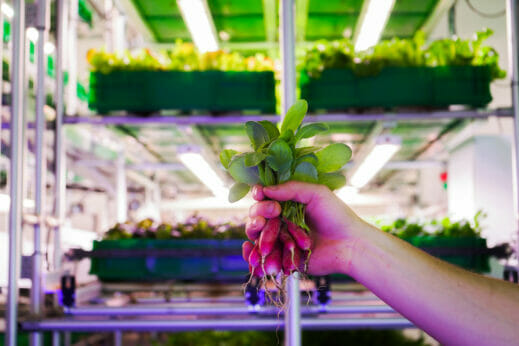Empty Offices to Vertical Farms

Turning Empty Offices Into Vertical Farms
With office usage hovering near 50 percent of pre-pandemic levels, many cities are struggling with a plethora of under-utilized space. Why not dedicate those desks and cubicles to growing food?
Empty Offices to Vertical Farms | Ciera O’ Brien |
In an old paper company and warehouse building, machines are whirring again. But instead of reams of paper pressed and cut, this warehouse is home to Area 2 Farms, which now pumps out greens, herbs and root vegetables. There’s even a weekly CSA serving customers year round, all in an effort to bring locally grown food to the Washington, DC area. Really local. “When was the last time you picked up a strawberry and could confidently say you knew the farmer’s name?” asks Jackie Potter.
Potter, along with Tyler Baras, helped co-found the farm in Arlington, VA, where office vacancy rates reached 23.7 percent in the first quarter of 2023.
Although the COVID-19 pandemic drove workers out of their offices over three years ago, many office buildings still remain deserted. According to data gathered in 10 major cities, office usage rates just crossed 50 percent of pre-pandemic levels in late January, and these numbers seem to be stalling only a few months later.
Nearly 20 percent of office space is empty across the United States, and some projections suggest that more than 300 million square feet of US office space could be obsolete by 2030. The pandemic has shown that people are capable (and in some cases, in favor) of working in a remote setting.
With many folks comfortably working from home offices, many downtown highrises serve as a looming frustration to landlords but also to local restaurants and small businesses that rely on office commuters to sustain business. So, many municipalities are trying to fill those spaces back up. In New York, city officials are transforming empty office buildings into apartments around parts of Midtown. Many other regions are also exploring this idea, including Washington, Los Angeles, Milwaukee, Chicago and Philadelphia. Although modifying an existing building is less expensive than rebuilding, turning offices into residential space can be costly, as most office spaces are laid out differently from residential buildings. But there are other options for these empty offices — such as farms.

Photography by Area 2 Farms.
Baras took this idea to heart when designing Area 2’s growing apparatus, Silo. Silo is a multi-level conveyor belt system that moves vertically throughout the day to replicate a plant’s natural circadian rhythm. Since the system moves automatically, Silo’s conveyor belt cuts down on some of the backbreaking work that accompanies traditional vertical farming methods, such as climbing up and down ladders. Also, Silo requires no modifications to the existing building before installation. Area 2 Farms plans on building a model of Silo in Union Station in D.C. later this year to showcase its growing technology and advocate for local food systems.
Just as cities have changed drastically over the past few years, Potter and Baras recognized that our modern food system is changing, too, and farmers must be ready to adapt. “The idea we have of what farms used to be is not what farms are today. There is no picturesque, red barn farm anymore,” says Potter.
In Calgary, Alberta, AgriPlay Ventures transformed part of underutilized office space in Calgary Tower Centre into one of Canada’s largest indoor urban farms earlier this year.
Dan Houston, president of AgriPlay, who has worked in the business for two decades, had long thought that vertical farming and office buildings were a natural match. “I didn’t know why [farms] weren’t in office buildings already. They should be, because the office market is so bad and it’s only getting worse,” says Houston. In addition to a struggling commercial real estate sector, Alberta is reported to have the highest rate of food insecurity among Canadian provinces; approximately one in five Alberta households is food insecure. The farm at Calgary Tower produces tomatoes, strawberries, cucumbers, greens and much more for the local community, some crops offering 30 harvests a year. Although only one floor of the approximately 262,500-square-foot building is currently being utilized for food production, AgriPlay wants to expand to the other two floors in the coming months and years. Currently, AgriPlay Farms is negotiating offers on more than one million square feet of office space in Calgary.
“The Calgary Tower was going to be a showcase of how to grow inside of the space of a building. Since then, we’ve already built a much superior product. We’re getting ready to extend into the rest of the building and the other spaces that we occupy,” says Houston.
According to Houston, office spaces already provide an ideal environment for growing food, since they are already air conditioned, heated and well ventilated. Not many modifications have to be made to the buildings themselves. Similar to Silo, AgriPlay’s growing system can also be easily installed in a wide variety of buildings and settings, which makes it an appealing prospect to potential landlords.
AgriPlay provides hardware that uses artificial intelligence to convert and install custom, plug-and-play modular growth systems. According to Houston, its scalable installation model was designed specifically to fit into existing office real estate spaces, and it doesn’t require prior knowledge of farming.
“Our system tells people what to do. I don’t need to know anything about growing strawberries. I just tell the system I’m growing strawberries and it sets the work up for me,” says Houston.
In time, AgriPlay hopes to become the technology provider that allows community stakeholders to market and grow in their own communities.
When executed correctly, vertical farming can yield as much produce as traditional farming methods in urban areas and smaller spaces. Additionally, vertical farmers gain the added benefit of yielding a consistent, year-round production without the uncertainties of climate or pests, all while utilizing 90 percent less energy and 98 percent less water than a traditional farm. Although it can’t be a replacement for more traditional methods, vertical farming provides fresh produce in areas that have little food production or access to healthy foods.
“It seems like we’ve hit a sweet spot where the entire world needs food security; it’s now a national security interest for most countries. At the same time, commercial real estate is imploding,” says Houston. “You put those two together, and you’ve got a fast, easy conversion method to onshore your food production and solve your commercial vacancy issues.”
Potter agrees, noting that utilizing empty office space for farming could reshape urban centers as we know them now.
“Cities are changing every day,” says Potter. “There’s a really great economic opportunity as well. Our farms create new green jobs, they beautify spaces and provide fresh food to local communities. That’s something that’s really precious.”
Original Article: https://modernfarmer.com/2023/07/turning-empty-offices-into-vertical-farms/
The post Empty Offices to Vertical Farms appeared first on GROZINE.



